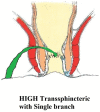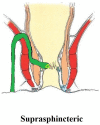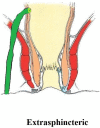Management of Complex Cryptoglandular Anal Fistula: Challenges and Solutions
- PMID: 33204136
- PMCID: PMC7667587
- DOI: 10.2147/CEG.S198796
Management of Complex Cryptoglandular Anal Fistula: Challenges and Solutions
Abstract
Anal fistulae can be a very difficult disease to manage. The management of complex fistulae is even more challenging. The risk to the fecal continence mechanism due to damage to the anal sphincters and refractoriness to the treatment (high recurrence rate) pose the two biggest challenges in the management of this disease. Apart from these, there are several other challenges in the treatment of complex fistulae. The intriguing and uphill task is that satisfactory solutions to most of these challenges are still not known, and there is hardly any consensus on whatever treatment solutions are available. To summarize, there is no gold-standard treatment available for treating complex anal fistulae, and the search for a satisfactory treatment option is still on. In this review, the endeavor has been to discuss and highlight recent path-breaking updates in the management of complex anal fistulae.
Keywords: anal fistula; classification; fistulotomy; incontinence; recurrence; sphincter.
© 2020 Garg et al.
Conflict of interest statement
The authors report no conflicts of interest for this work.
Figures





References
-
- Jayne DG, Scholefield J, Tolan D, et al. A multicenter randomized controlled trial comparing safety, efficacy, and cost-effectiveness of the surgisis anal fistula plug versus surgeon’s preference for transsphincteric fistula-in-ano: the FIAT trial. Ann Surg. 2020. doi:10.1097/SLA.0000000000003981 - DOI - PubMed
-
- Garg P. Garg classification for anal fistulas: is it better than existing classifications?- A review. Indian J Surg. 2018;80(6):606–608. doi:10.1007/s12262-018-1788-2 - DOI
Publication types
LinkOut - more resources
Full Text Sources

